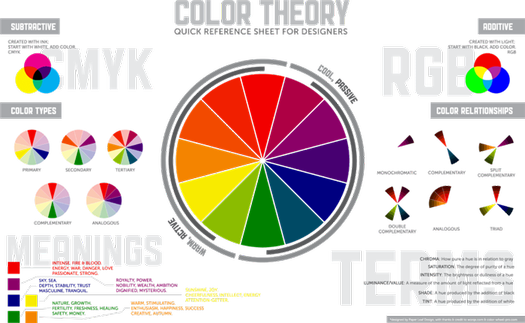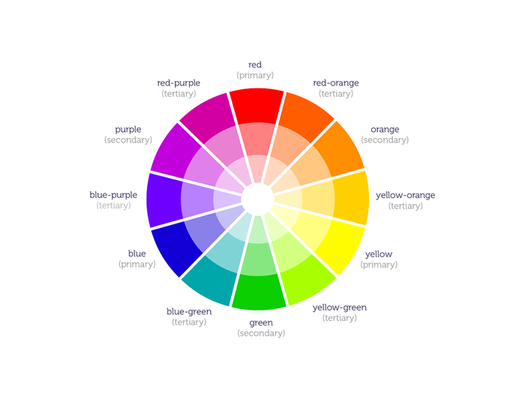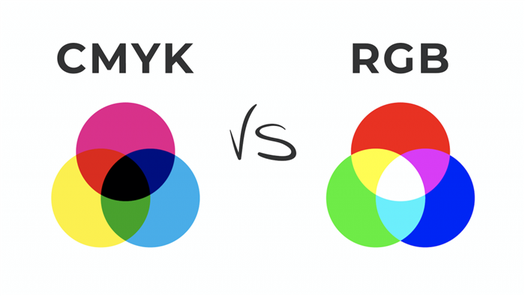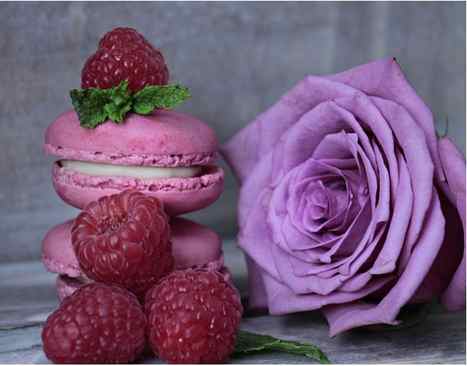It may not be as straightforward as you think it is, so let’s begin!
Red and Purple Mixed! What Color Do Red and Purple Make? (Updated 2023)
Curious what happens when red and purple are mixed together? We will reveal the answer in this article.
Whether it’s for painting, fashion style, web design, or day-to-day makeup, it’s always a good thing to know the relationships between each hue and what color combinations will lead to your desired color outcome.
To ensure a good start, it’s best to always begin your colorful discovery with popular hues, such as red and purple, for instance.
Sure, while the two are popular and widely used as individual color choices, combining them would provide you with yet another brilliant hue that is sure to give your craft more depth and style.
To help you with that, we have prepared a brief guide that will enable you to identify the proper ways to categorize colors and know what to expect when you combine certain pairs.
Color Theory: Understanding Color Relationships
Of course, while each color carries the beauty of its own, combining some together can lead to an even more stunning result.
However, this is not always the case. Since each hue has its own distinct set of features and functions, randomly mixing one with another isn’t always a wise thing to do.
In fact, when mixing colors, artists and designers are advised to review what we call “Color Theory” first.
What is Color Theory?
Generally, when we speak of Color Theory, this refers to the set of rules and principles related to the science and art of using colors.
Since designers and artists mostly rely on colors to communicate with their audience, evoke certain emotions or set a particular mood in an art piece, color theory sets the fundamental guidelines enabling them to choose the right colors and combinations to achieve their desired results.

Overall, this includes which colors create visual contrast or harmony when brought together and which colors aren’t fit to be mixed or placed alongside each other.
To understand Color Theory, designers and artists are provided with what we call the Color Wheel.
What Is the Color Wheel?
To explain simply, the Color Wheel is the very basis of Color Theory. It works as a circular diagram of colors arranged specifically to display their chromatic relationships.
Under this arrangement, colors that are placed on opposite sides of the circle are called “Complementary Colors.”
When these colors are used together or placed alongside each other, they create high contrast that helps them appear brighter and more prominent.
Meanwhile, those that are positioned side by side on the wheel, such as orange, yellow, and green, for instance, are called “Analogous Colors.”
These are colors that are very similar but have different traits or functions. When used together, they create a serene and comfortable result.
Within the color wheel, colors are generally divided into three categories: primary, secondary, and tertiary.

When we speak of primary colors, these refer to the colors red, yellow, and blue, which are recognized to be the parent colors of all other succeeding colors.
Secondary colors, on the other hand, are those that are produced by combining two primaries together. These include orange, which is made by mixing yellow with red; green, which is the result of blue and yellow; and purple, which is created from red and blue.
Lastly, tertiary colors are those that are created by mixing a primary with a secondary. These include the colors red-orange, yellow-orange, yellow-green, blue-green, blue-violet, and red-violet.
What Color Do Red and Purple Make?
Now that you’ve had a brief review of Color Theory, it’s now easy to identify what colors different combinations produce.
In the case of red and purple, we would expect the mixture to appear reddish-purple, which could mirror the colors magenta or mauve , depending on the intensity and amount of the colors that were used.

Generally, since purple is made by mixing red with blue, the color purple itself already contains a certain degree of redness.
Knowing this, it’s wise to use only a small amount of each hue to avoid ending up with a muddy mess.
For an even better outcome, some also advise using a shiny red and a shiny purple together and creating the mixture by layering them instead of mixing them together.
What Do Purple and Red Make When Mixing Paint?
Red is a primary color and purple is a secondary color. So, when they mix together, they create a tertiary color known as red-purple or red-violet. Many people also refer to this color as magenta, although it’s darker than the magenta you get when mixing lights.
What are Tertiary Colors?

Tertiary colors are a combination of a primary color and a secondary color. These two colors are usually close to each other on the color wheel because otherwise, they might create a muddy mixture.
There are six tertiary colors on the RYB color model: yellow-orange , red-orange , red-purple , blue-purple , blue-green , and yellow-green . Based on the names, it’s easy to guess which colors these are mixtures of.
The names make it easy to learn the color wheel, but many artists prefer to use more specific names, such as chartreuse , teal , and amber . In this case, magenta is the more specific name for red-purple.
How to Make Shades and Tints of Red-Purple

Red-purple is a beautiful color, so you might want to use it in your art pieces. There are lots of variants of red-purple, which can be made by mixing in other colors.
Mixing Tints
The best way to make a tint of red-purple is to add white. Since white is such a light color, you’ll need to mix in a significant amount before you notice a difference.
Adding more red can lighten the mixture too, but it’s not recommended since purple already has red in it. So, the mixture is already mostly red with a touch of blue.
Mixing Shades
To create a darker shade, you can add a hint of black or blue into the mix. With black paint, less is more. Only use it sparingly to make sure it doesn’t overpower the other colors.
Also, adding too much blue could make the mixture look more blue-purple than red-purple. So, creating a darker mixture can be a little tricky.
Does Red-Purple Have a Meaning?

Since red-purple more commonly goes by ‘magenta,’ it has a well-known meaning. Magenta symbolizes kindness, harmony, and change. It gives off supportive and inspiring feelings, encouraging people to find a sense of balance in their lives.
However, like most colors, magenta has some negative symbolism too. It can sometimes irritate others, likely because its bright, vibrant coloring is a lot to handle. For the most part, it’s uplifting and welcoming, but it can have some downsides depending on who’s looking at it.
Can You Mix Colors to Create Purple and Red?
While purple and red mix together to make red-purple, other colors can mix together to make red and purple too. Purple is an easy color to mix because it’s a secondary color. So, it’s a combination of 50% red and 50% blue.
However, red is a primary color, so you’ll have to do subtractive mixing with the CMYK color model to get it. According to that model, magenta and yellow mix together to create red.
What Do Purple and Red Make When Mixing Lights?

Mixing colored lights is a lot trickier because it uses the RGB color spectrum. On there, red is still a primary color, but purple is now a tertiary color. Tertiary colors are rarely mixed with other colors. When it comes to lights, purple is usually referred to as violet instead.
In the RGB color model, red and blue make magenta instead of purple. Then, purple is made by mixing magenta and blue together. So, if you add red to purple , you will go back to a nice magenta mixture, brighter than the one you get with paint.
Understanding Light Mixtures
Mixing lights is a lot different than mixing paint. Not only are you using a different color model, but you’re also adding the colors on top of each other instead of swirling them together. In lights, all colors are made by mixing blue, red, and green at different brightnesses.
Purple in lights is usually bright blue and red with only a little bit of green mixed in. Of course, this varies based on the type of purple you want. Yet, when you add more red into the mixture, that means the red’s brightness will increase, changing the color back to magenta or pink.
As mentioned earlier, red and blue make magenta in lights. Adding a little more blue to magenta creates violet, so adding red to violet will create an even mix of red and blue again, which is magenta. Thus, mixing red and purple in lights isn’t practical, but it can help you get a better idea of how the RGB color model works.
How Do Our Eyes Perceive Color?

We see colors everywhere we go, but a lot happens in order for our eyes to see those colors. It has a lot to do with the wavelengths on the visible light spectrum, which includes the colors you normally see in a rainbow. Violet is at one end of the spectrum, and it has short frequent wavelengths. Then, red is at the other end of the spectrum, and it has long wavelengths.
An object’s properties determine which wavelengths will be absorbed into it and which ones will reflect off it. For example, grapes often look purple because violet is the only color that reflects off them. Other colors like red, blue, cyan, green, yellow, and orange are all absorbed instead. So, only short, purple wavelengths are reflected toward your eyes to help you perceive the color.
In your eyes, there are cone and rod cells, which help your vision respond to colors. Cone cells work best in bright lights, while rods are more sensitive and see colors better in dim lights. Both cell types work together to help you see colors no matter the lighting. Animals see colors in a similar way to us, but humans usually have the best color vision. Although, these animals may see more colors than us.
Purple vs. Violet
Purple
Hex: #800080
RGB: 128, 0, 128
CMYK: 0, 100, 0, 50
Violet
Hex: #8F00FF
RGB: 143, 0, 255
CMYK: 44, 100, 0, 0
Purple and violet are sometimes used interchangeably for the same color. In painting, it’s usually called purple while lights call it violet instead. However, by definition, these two colors are slightly different.
Purple is supposed to be a 50/50 mixture of red and blue. Yet, violet is described as having a little more blue than red. It’s a very minor difference, but it’s easy to notice when you see the two colors side by side.
Do Purple and Red Go Together?

Usually, two colors close to each other on the color wheel are commonly used together in design. That’s not the case with red and purple. Magenta looks great with both colors, but red and purple tend to clash with each other. This can happen because red is a warm color while purple is a cool color. Warm and cool colors sometimes conflict because they provoke different feelings.
Yet, red and purple can look great together when designed well. Since they’re not a combination you see often, they’re sure to catch your eye. The best way to create a soothing design with these colors is to use lots of purple but then add red accents here and there. This can work well for both art pieces and room designs.
So, despite popular belief, red and purple can go really well together. Just make sure you put a lot of thought into your design before executing it. Consider the meanings of red and purple and how they might clash. Mixing red and purple hair dye has also been known to create a unique effect when done correctly.
Do Red and Purple Always Make Magenta?
Whether you’re mixing with paint, ink, or lights, red and purple will make some type of red-purple or magenta. This might not sound shocking, but when you look at other color mixes, the results can vary. That’s because paints use red, yellow, and blue for primary colors, while lights use red, green, and blue instead. So, the mixtures aren’t always consistent.
For example, mixing red and green creates brown paint but yellow lights. Also, red and blue make purple in painting, but they make magenta in lights. So, it’s unlikely that the results will be the same for every medium. Yet, red and purple are an exception.
Even though red and purple sit close to each other on the color wheel, they’re very different colors. However, they can work beautifully together in certain designs. Magenta is also a wonderful color to use despite being unfamiliar to many. So, consider branching out and exploring new colors in your art pieces and designs.
Best uses for red and purple mixes
Now, you may be wondering what some of the ways you can use red and purple are. The answer is that there are thousands of answers!
As we mentioned, these are two colors that have romantic connotations to them. When adding hearts to a love letter, they will often have shades of red and purple to make them more pleasing.
Therefore, this color combination would be perfect around Valentine’s Day or maybe an anniversary.
This can be true whether the colors are mixed or separated, and you can come up with some amazing combinations!
Of course, romantic designs are not the only way that you can use red and purple. In nature, red and purple can be quite common to behold.
You can find many flowers with red and purple petals for example. Some birds and parrots sometimes have beautiful red and purple feathers as well.
Sometimes the sky can have elements of red and purple as well that can look really stunning. You may be surprised to find out how much red and purple can appear in pictures.
This is true whether it’s a mixture of the two or when they’re used separately.
The combination of these colors also works really well for a stylized image that gives off relaxed feelings. You will often see red and purple used in different forms of digital art.
It can also be a combination of colors that works well with interior decorating and even wall colors. As you can see, it can be a really versatile set of colors that can be at your disposal!
The main thing you need to consider is what you could personally need these colors for. Whether you are painting a beautiful sunset or an intimate picture of a wine glass, there are so many uses.
Now that we have determined that red and purple are a great mixture, you may still be wondering how you can use them to their full advantage.
In the next step, we will look at some of the ways that red and purple can be combined with different shades and different colors to create your own perfect color creations.
Let’s proceed and see how it can be done!

Lighter and darker red and purple mixes
If you don’t put too much thought into it and mix a random combination of red and purple, you probably won’t end up with the color you wanted immediately.
This is true if you’re trying to replicate a specific color for a real subject or go for a more stylistic approach. If you don’t immediately have the color you want, there are lots of ways to fix it!
For an example, we will say that you are painting a flower with magenta petals. First, try to find a clear source to work from.
This could be a high-resolution image of the flower, or you might even have a real one to work from. Once you have your source, try to really look closely at the colors.
For the purple flower, you can see that maybe it has a mild red or blue tone to it, for example. So once you have added the red and purple, you might need to add a spot of red to the mix.
It’s all about being observant to determine what colors might be needed. You might need to make the color darker or lighter, and there are a few ways to do that.
The easiest way is to use white to make it lighter or black to make it darker. Try not to use too much of these colors to begin with as it can overpower the colors if used in too great a quantity.
Adding black and white is a quick way to achieve these different tones, but you can also make it more nuanced. For instance, you may notice that the purple has a blueish tone to it.
In that case, if the color isn’t dark enough then you can incorporate a few spots of dark blue. That is one way you can make it darker or lighter while sticking to the color tones of the subject you are working on.
It can take a careful eye to note these tones, so close observation is the key to achieving realism or the style you would like.
What are some ways you would like to use the combination of red and purple in your art?
In summary
Red and purple are two beautiful colors, and this is only more the case when used together. You set out to answer the question of what color does red and purple make when mixed, and now you know!
This is just the beginning, though, and now it’s up to you to unlock all of the potential of these colors.
Whether you use them mixed together or with one another, you can land up with some amazing results.

Just remember to be observant and keep experimenting until the colors are exactly what you want for whatever piece of art you are trying to create!





